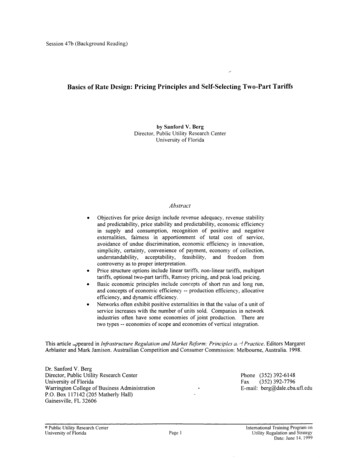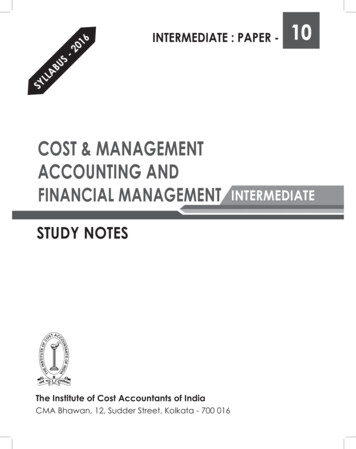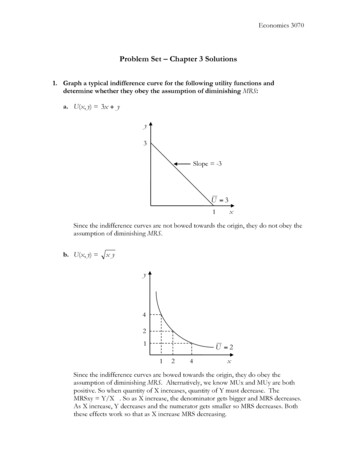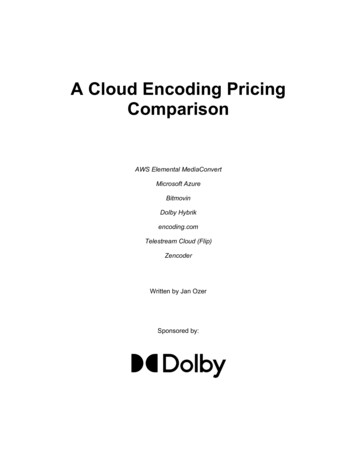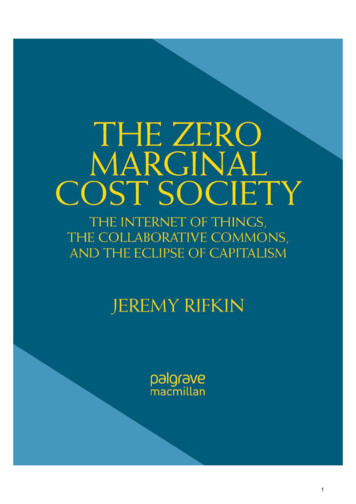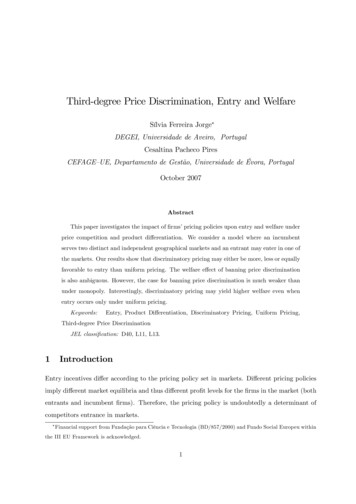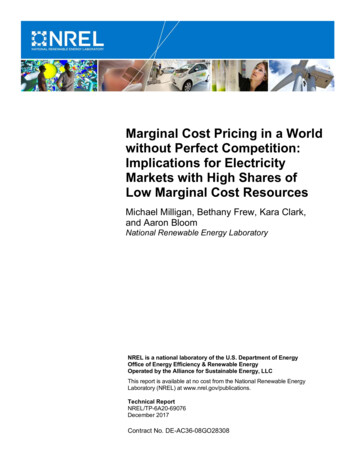
Transcription
Marginal Cost Pricing in a Worldwithout Perfect Competition:Implications for ElectricityMarkets with High Shares ofLow Marginal Cost ResourcesMichael Milligan, Bethany Frew, Kara Clark,and Aaron BloomNational Renewable Energy LaboratoryNREL is a national laboratory of the U.S. Department of EnergyOffice of Energy Efficiency & Renewable EnergyOperated by the Alliance for Sustainable Energy, LLCThis report is available at no cost from the National Renewable EnergyLaboratory (NREL) at www.nrel.gov/publications.Technical ReportNREL/TP-6A20-69076December 2017Contract No. DE-AC36-08GO28308
Marginal Cost Pricing in aWorld without PerfectCompetition: Implications forElectricity Markets with HighShares of Low Marginal CostResourcesMichael Milligan, Bethany Frew, Kara Clark,and Aaron BloomNational Renewable Energy LaboratoryPrepared under Task No(s). WEPG.10347. 09.01.01NREL is a national laboratory of the U.S. Department of EnergyOffice of Energy Efficiency & Renewable EnergyOperated by the Alliance for Sustainable Energy, LLCThis report is available at no cost from the National Renewable EnergyLaboratory (NREL) at www.nrel.gov/publications.National Renewable Energy Laboratory15013 Denver West ParkwayGolden, CO 80401303-275-3000 www.nrel.govTechnical ReportNREL/TP-6A20-69076December 2017Contract No. DE-AC36-08GO28308
NOTICEThis report was prepared as an account of work sponsored by an agency of the United States government. Neitherthe United States government nor any agency thereof, nor any of their employees, makes any warranty, express orimplied, or assumes any legal liability or responsibility for the accuracy, completeness, or usefulness of anyinformation, apparatus, product, or process disclosed, or represents that its use would not infringe privately ownedrights. Reference herein to any specific commercial product, process, or service by trade name, trademark,manufacturer, or otherwise does not necessarily constitute or imply its endorsement, recommendation, or favoringby the United States government or any agency thereof. The views and opinions of authors expressed herein donot necessarily state or reflect those of the United States government or any agency thereof.This report is available at no cost from the National Renewable EnergyLaboratory (NREL) at www.nrel.gov/publications.Available electronically at SciTech Connect http:/www.osti.gov/scitechAvailable for a processing fee to U.S. Department of Energyand its contractors, in paper, from:U.S. Department of EnergyOffice of Scientific and Technical InformationP.O. Box 62Oak Ridge, TN 37831-0062OSTI http://www.osti.govPhone: 865.576.8401Fax: 865.576.5728Email: reports@osti.govAvailable for sale to the public, in paper, from:U.S. Department of CommerceNational Technical Information Service5301 Shawnee RoadAlexandria, VA 22312NTIS http://www.ntis.govPhone: 800.553.6847 or 703.605.6000Fax: 703.605.6900Email: orders@ntis.govCover Photos by Dennis Schroeder: (left to right) NREL 26173, NREL 18302, NREL 19758, NREL 29642, NREL 19795.NREL prints on paper that contains recycled content.
AcknowledgmentsThe authors thank Richard O’Neill (Federal Energy Regulatory Commission), Beth Garza(Potomac Economics), and Venkat Krishnan and Dan Steinberg (National Renewable EnergyLaboratory) for their thoughtful reviews, comments, and suggestions. We especially thankCharlton Clark (U.S. Department of Energy) for sponsoring this work. We are grateful for theeditorial support from Katie Wensuc (National Renewable Energy Laboratory) and MaureenMcIntyre (McIntyre Communications). This research was funded by the U.S. Department ofEnergy, Office of Energy Efficiency and Renewable Energy, Wind and Water PowerTechnologies Office under contract number DE-AC36-08GO28308. The U.S. Governmentretains and the publisher, by accepting the article for publication, acknowledges that the U.S.Government retains a nonexclusive, paid up, irrevocable, worldwide license to publish orreproduce the published form of this work, or allow others to do so, for U.S. Governmentpurposes. Any and all errors are the sole responsibility of the authors.iiiThis report is available at no cost from the National Renewable Energy Laboratory at www.nrel.gov/publications.
List of verage total costCalifornia Independent System Operatorcapacity remuneration mechanismsElectric Reliability Council of TexasFederal Energy Regulatory CommissionHerfindahl-Hirschman Indexmarginal costmarginal revenueMidcontinent Independent System Operatoroperating reserve demand curvepower purchase agreementregional transmission organizationivThis report is available at no cost from the National Renewable Energy Laboratory at www.nrel.gov/publications.
Executive SummaryA common approach to regulating electricity is through auction-based competitive wholesalemarkets. The goal of this approach is to provide a reliable supply of power at the lowestreasonable cost to the consumer and to enable transparency and mitigate market power, definedas the ability of a market actor to influence the market price or exclude competition. Thisnecessitates market structures and operating rules that ensure revenue sufficiency for allgenerators needed for resource adequacy purposes. Wholesale electricity markets employmarginal-cost pricing to provide cost-effective dispatch such that generators are compensated fortheir operational costs. However, marginal-cost pricing alone cannot guarantee cost recoveryoutside of perfect competition, and current electricity market structures have at least sixattributes that preclude them from functioning as perfectly competitive markets. These attributesinclude externalities, public good attributes of the network, ineffective demand curve, marketpower, wholesale price caps, and lack of large-scale storage.Some of these attributes—namely externalities and public good attributes (in this case, of thenetwork)—are classic sources of market failure and exist in today’s electricity market construct.The ineffective demand curve feature is arguably the most impactful contributor to marketfailure and refers to the inability of consumers to express their actual demand for electricity. Itresults from the “demand-side flaws” of demand inelasticity and the system operator’s inabilityto control the real-time flow of power to specific customers.1 Other attributes—primarily marketpower, lack of large-scale storage, and wholesale price caps—have compounding causes andeffects that amplify underlying market failures. For example, market power exists in partbecause of significant barriers to entry that yield monopolistic tendencies. Electricity markets areregulated to minimize this market power, but the resulting regulatory-imposed average-pricebased retail rate structures contribute to the observed inelastic demand mentioned above.Similarly, the wholesale price caps that are implemented to restrict market power may alsoprevent prices from reaching levels needed to ensure adequate revenues for generators. Inaddition, imperfect information related to the planning and operation of the power system, suchas uncertainty in load growth and future economic and policy factors, further amplifies thesecurrent market structure failures.Until (and unless) these contributors to market failure are ameliorated, some form of correctiveaction(s) will continue to be necessary to improve market efficiency so that prices can correctlyreflect the needed level of system reliability. Many of these options necessarily involve someform of administrative or out-of-market actions, such as scarcity pricing, capacity payments,bilateral or other out-of-market contracts, or some hybrid combination. A key focus with theseoptions is to create a connection between the electricity market and long-term reliability/loss-ofload expectation targets, which are inherently disconnected in the native, unaltered marketsbecause of the aforementioned contributors to market failure.The addition of low marginal cost resources, such as generators fueled by low-cost natural gasand near-zero marginal cost wind and solar generators, can further exacerbate revenuesufficiency and resource adequacy concerns caused by these underlying market failurecontributors. These low marginal cost resources effectively suppress energy prices and reduceThe price elasticity of demand is the sensitivity of demand to a change in price and can be separated into long-runand short-run elasticities. If a 10% increase in price causes a 20% reduction in demand, then the elasticity is 2(technically, this is a negative value, but the common convention is to redefine it as positive) (Stoft 2002).1vThis report is available at no cost from the National Renewable Energy Laboratory at www.nrel.gov/publications.
the capacity factors of conventional generators through the merit-order effect in the simplest caseof a convex market; non-convexities can also suppress prices, even outweighing the impact oflow marginal cost generation. 2Additionally, the uncertainty and variability of variable generation resources, such as wind andsolar, requires more system flexibility. This can be achieved by a wide range of supply-side anddemand-side options for physical flexibility. This also necessitates institutional flexibilityoptions, including new market designs, greater regional coordination, and fair cost allocation.Future research is needed to assess optimal market designs that are technology neutral, robust togenerator fleet composition, and politically/socially acceptable, while ensuring revenuesufficiency of power system assets needed for reliability. Various modeling tools are needed forthis effort to span multiple time horizons, including planning and operational decision timeframes.2We use the term convex market to describe a market where the unit commitment decisions are not considered in themarket solution and each unit has a monotonically increasing supply cost function. Sources of non-convexities inreal markets are from no-load costs, start-up costs, and certain constraints on generator output such as minimumgeneration levels and operating time limits. Non-convex representations could include a discontinuous ornonmonotonic supply curve. Non-convexities result in deviations from perfect competition, including inefficient—or the absence of—market equilibrium prices.viThis report is available at no cost from the National Renewable Energy Laboratory at www.nrel.gov/publications.
Table of Contents1234Introduction . 1Basic Market Types . 32.12.22.32.42.5Perfect Competition. 4Monopoly . 6Monopolistic Competition. 8Oligopoly. 9Market Outcomes . 113.13.2Near-Zero Marginal-Cost Examples . 12Market Failures . 143.2.1 Market Power . 143.2.2 Public Goods . 153.2.3 Externalities. 16Market Structure Complications . 12Electricity Markets . 184.14.24.34.44.54.64.7Electricity Market Inefficiencies . 18Revenue Sufficiency . 22Resource Adequacy . 26Impact of Variable Generation . 27U.S. Wholesale Electricity Market Examples to Minimize Revenue Sufficiency and ResourceAdequacy Challenges . 29Complicating Factors and Unintended Consequences for Market Design . 30Future Research . 315 Summary and Conclusions . 32References . 33Appendix: Cost Definitions and Curves . 40viiThis report is available at no cost from the National Renewable Energy Laboratory at www.nrel.gov/publications.
List of FiguresFigure 1. Basic market types along a continuum . 3Figure 2. Short-run equilibrium of a perfectly competitive market. The left panel shows an individualrepresentative firm, and the right panel shows the market. . 5Figure 3. Long-run equilibrium in perfect competition . 5Figure 4. Monopolistic market equilibrium . 7Figure 5. Monopolist with declining average total cost during the relevant market range of output . 8Figure 6. Monopolistic competition in the short run (left) and long run (right) for a representative firm . 9Figure 7. One potential diagram of oligopoly with economic profit . 10Figure 8. The derivation of the demand curve for a private good (left) and a public good (right) . 16Figure 9. Negative externalities are not taken into account in the market supply curve, S, and equilibriumquantity, q, and price, p. Supply curve S' and associated p' and q' show the impact of theexternality in the market outcome. . 17Figure 10. Stylistic representation of multiple contributors to market failure in electricity markets . 19Figure 11. Impact of variable renewable generation on market prices. Image from Frew et al. (2016a). 28List of TablesTable 1. Comparison of Key Outcomes for Different Market Types . 11Table 2. Example of Market Power: Communications . 13Table 3. Pricing Example from Communications Industry . 13Table A-1. Cost Definitions and Curves Relevant to Electricity Markets . 40viiiThis report is available at no cost from the National Renewable Energy Laboratory at www.nrel.gov/publications.
1 IntroductionElectricity, by its nature, requires some form of regulation. There are a variety of welldocumented market failures 3 that result in a classical “public good” problem (Joskow 1997, 119–138). Some of the most frequently mentioned market failures relate to the inelasticity of demand,nonexclusivity, market power, externalities, and pure monopoly of transmission.1 In light of suchmarket failures, state and federal regulators have developed two basic approaches to regulatingthe electricity industry: (1) cost-of-service regulation and (2) auction-based competitivewholesale markets. The common objectives are to ensure that sufficient generation andtransmission resources are procured and operated to meet expected conditions at the least costand to ensure that the owners and operators of the necessary system resources can earn a fair rateof return.First, the classic approach to addressing the public good problem of the electricity industry iscost-of-service regulation. With this approach, electric utilities operate a regulated monopolywhereby all prudently incurred costs for electricity supply and transmission are entitled to aregulatory approved rate of return.However, in the early 1990s, several countries developed an alternative regulatory paradigm toaddress market failures related to the supply of electricity. The fundamental premise is thatelectricity transmission is a pure monopoly and must be operated in an independent manner toenable competition among electricity generators. Instead of guaranteeing a rate of return forgeneration, this second approach enables generation owners to earn revenues based on the resultsof an independently operated, auction-based market. This approach is designed to addresssupply-side market failures related to planning reserve margins, efficient operation, and marketpower (Hogan 2008). A key argument for these markets—generally referred to as regionaltransmission organizations (RTOs) in the United States—is that they create a more competitivemarket by increasing transparency, reducing the impact of market power, and lowering costs toconsumers by co-optimizing operations. In this paper, we focus on the structure and performanceof auction-based markets implemented in RTOs.Although there are differences in many of the details in wholesale electricity market design, acommon premise is that a large number of competitive generators can deliver electricity supplywhile regulatory measures can be enacted to limit the exercise of market power and theassociated distortions of competitive prices. 4 Under this premise, marginal-cost pricing results ina cost-effective dispatch such that generators are compensated for their operational costs. 5Generators rely on times when the market clearing price is more than their marginal cost (MC),The term market failure is standard in economics. The term does not necessarily refer to a full market collapse;rather, it means that one or more imperfections prevent the market from achieving an economically efficientsolution—i.e., a solution that is both allocatively and productively efficient. See Section 3.2 for details on classicsources of market failure.4Throughout this paper, the term price refers to the price of market products at the bulk power system level.5For a given dispatch or market period, the resource is compensated for variable costs; however, additional out-ofmarket payments might also apply. These include uplift (or make-whole) payments to cover no-load or start-up costsand day-ahead profit guarantees to prevent generators from losing profits earned in the day-ahead market whenthose generators would lose money by performing actions that benefit the system in the real-time market. Possiblecauses for these out-of-market payments include misalignment of average and marginal-cost curves anddiscrepancies between day-ahead and real-time operational conditions (e.g., Wang 2016).31This report is available at no cost from the National Renewable Energy Laboratory at www.nrel.gov/publications.
such as during scarcity pricing events, to provide additional revenue to cover fixed costs;however, such long-term, fixed-cost recovery is not guaranteed under the marginal-cost pricingpremise, and this is a key focus of this paper. More broadly, this paper’s position is that there isno reason to expect that marginal-cost pricing alone (i.e., without improvements to underlyingmarket failures or administrative measures to compensate for flaws in energy price formation)will necessarily lead to a stable long-term electricity market or ensure resource adequacybecause: Existing markets with similar structures (monopolistic competition and oligopoly) havedifficulties in the long run with marginal-cost pricing. Specifically, under marginal-costpricing, when the marginal cost is less than average total cost (ATC), prices areinsufficient to cover both fixed and variable costs to support current generators or signalnew capacity that might be needed for long-term system reliability. 6 No link exists between reliability and pricing unless reliability (or capacity) is priced inaddition to energy pricing. Even though some reserve pricing might be effective in the short to medium term, it isnot clear that this current approach is robust in a future with high penetration levels ofvariable generation and large amounts of quick-start capability, when the reserve marketis likely saturated due to excess capacity for large parts of the year.Many markets have been influenced recently by depressed energy prices, driven by lower-thanexpected demand, historically low natural gas prices, and the adoption of near-zero marginal-costvariable generation, such as wind and solar (Hibbard et al. 2017). The purpose of this paper is todisentangle these surface layer challenges from the underlying market failures to betterunderstand the function and maximize the potential of electricity markets. We aim to bridge thegap—and motivate further dialogue—between the related but often separate topics of economicsand power systems. We begin in Section 2 by describing the four basic market types: perfectcompetition, monopoly, monopolistic competition, and oligopoly. We then use economicprinciples to examine the basic outcomes of these four markets and show that marginal-costpricing is economically sustainable only within a perfectly competitive market. In Section 3, wecite some evidence showing that most markets in the United States do not exhibit perfectcompetition, and we explore pricing structures in other industries that might provide insight. Wethen discuss the unique and complicating characteristics of electricity markets in Section 4, witha discussion of existing and plausible electric power market structures for an evolving powersystem. We do not advocate for any specific market structure but rather aim to present asampling of market structure types and design considerations.This reference to long-term reliability is separate and distinct from the common N-1 operational reliabilitystandard. The reliability focus of this paper is on resource (or capacity) adequacy, specifically for long-term capacityneeds, but also for shorter-term system balance and flexibility requirements. In addition, the term sustainability orsustainable can be applied to markets where revenues are sufficient to support a resource-adequate system; wejointly use the terms revenue sufficiency and resource adequacy throughout this paper to refer to a sustainablemarket. Price-responsive demand (i.e., downward sloping demand curve) is critical to achieving these objectives,and the lack of this price responsiveness is a key contributor to market failure preventing a sustainable or efficientmarket, as discussed in Section 4.1.62This report is available at no cost from the National Renewable Energy Laboratory at www.nrel.gov/publications.
2 Basic Market TypesThis section provides an overview and background of the basic market types according tomicroeconomic theory. The intent is to provide a basic background for readers who may not havea background in this subject and can be skipped by those who do. Recognizing the differencesamong these market types is critical to understanding, from a foundational level, the limitationsof electricity markets; those readers interested only in the discussion on electricity markets arereferred to Section 4.The four basic market types are (1) perfect competition, (2) monopoly, (3) monopolisticcompetition, and (4) oligopoly. In reality, these four market types represent points along acontinuum because real markets can sometimes consist of a blend of market types. This is shownin Figure 1. We ignore economic externalities and public goods in this section to focus directlyon the market structure, but both topics are introduced in Section 3. Our primary focus is on therelationship between price and marginal cost, and we show that in most of these market types,price diverges from marginal cost.Figure 1. Basic market types along a continuumAs shown in Figure 1, a key characteristic of any market type is the degree of market power.Market power refers to the ability of a market actor to influence the market price or excludecompetition. Two common ways to quantify market power are to use (1) four-firm concentrationratios (sometimes five firms are used instead) and (2) the Herfindahl-Hirschman Index (HHI). 7In both cases, the market share is defined as the percentage of all market transactions undertakenby one or more firms relative to the entire market. The four-firm concentration ratio is the sum ofthe top four firms’ percentages of the total market. Conversely, the HHI is calculated as the sumof squares of all firms’ market shares.These market shares and concentration measures are applicable within the broader economics landscape.Concentration metrics such as HHI only account for one of five economic factors that determine the extent ofmarket power; the other four are demand elasticity, style of competition, forward contracting, and geographic extentof the market (Stoft 2002). As a result, a better measure of market power is HHI/e where e is the demand elasticity.See Section 4.1 for a description of market power metrics used more commonly within electricity markets. Thesemethods generally focus on generator offer prices and binding transmission constraints.73This report is available at no cost from the National Renewable Energy Laboratory at www.nrel.gov/publications.
On the far left of the spectrum shown in Figure 1, a perfectly competitive market has manyfirms, none of which has significant market power. There could be, for example, 100 firms, eachof comparable size. The HHI for this example would be 100. Moving to the right, a monopolisticcompetition market could be characterized by an HHI less than 1,000; a monopolistic HHI wouldbe 10,000, and an oligopoly would lie somewhere in between. These HHI limits are not strictlydefined, but they generally describe the standards that are used by the U.S. Department of Justiceto screen and mitigate market power, specifically when evaluating mergers. 82.1 Perfect CompetitionThe purest form of competition is known as perfect competition. 9 Perfectly competitive marketsconsist of a large number of buyers and sellers to whom perfect information is always available.Neither producers nor consumers can individually impact price; thus, all market participants areprice takers. All costs of production are known, and no external costs or benefits accrue to partiesoutside the transaction. Consumers are not able to discern any differences among goods suppliedby different sellers (identical goods), and firms can freely enter or exit the industry. All goods orservices bought and sold in this type of market are fully excludable; consumers who do not paycannot consume the good/service. Consumption is rivalrous, and therefore consumption of thegood/service by one consumer implies that another consumer will be required to purchase his/herown product to consume. All firms are assumed to produce the quantity of output that willmaximize profits, subject to technical and market constraints and parameters.To a noneconomist, these conditions might appear to be severely restrictive. In fact, they are, andthis is why “perfect” is part of the name of this type of market. In reality, perfectly competitivemarkets do not exist in this pure form, although some markets might come close. But mostmarkets are generally considered to be monopolistically competitive (buyers and/or sellers havesome degree of market power, and products are not identical), oligopolistic (a small number ofsellers), or monopolistic (one seller), all of which we discuss.Perfectly competitive markets can be shown to achieve short-run equilibrium at the point atwhich price equals marginal cost (P MC) (Bade and Parkin 2002). Although individuals haveno discernable influence on price, the aggregation of buyers creates a downward-sloping demandcurve; and the aggregation of sellers’ marginal-cost curve, which can be shown to represent thefirms’ supply curve, creates an upward-sloping market supply curve. In the short run—defined asthe period of time during which capital, or other productive factor, cannot be changed—somenumber of firms could earn positive economic profit. 10 This is shown in Figure 2. The left panelshows the marginal cost and average total cost curve of a representative firm. P designates theprice per unit, and q represents the quantity of output per period. Because the firm is a pricetaker,
Wholesale electricity markets employ marginal-cost pricing to provide cost-effective dispatch such that generators are compensated for their operational costs. However, marginal-cost pricing alone cannot guarantee cost recovery outside of perfect competition, and current electricity market structures have at least six
